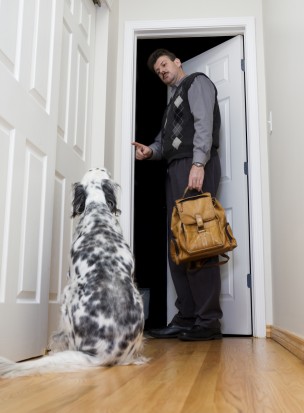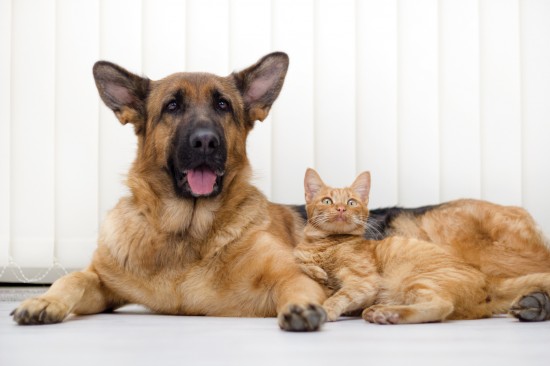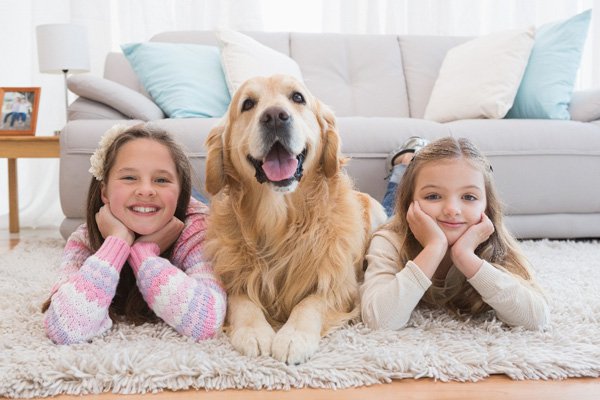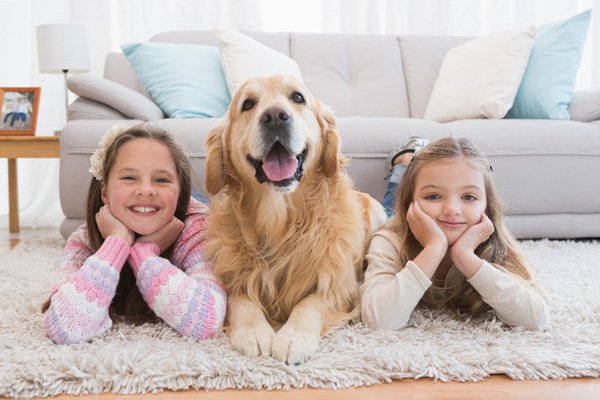

Most dog owners are familiar with the experience of fighting their dog to get through a doorway, and in some homes, this comes down to a constant battle over who should go first! Added to this, the sound of the doorbell, door knocker or someone walking up to your home will send many dogs into a frenzy of barking, jumping up and clamouring to see the visitor. It is also important that your dog learns that an open door to the outside is not always a green card to go through it, and to look to you for direction when it comes to their comings and goings!
In this article, we will look at the different aspects of teaching dogs about doors and doorways, and how to promote good door etiquette in your dog.
Your dog should always defer to you as the alpha when it comes to allowing you to go first in all things, be it eating, walking, or passing through a doorway together. Dogs that are very forward going, particularly on the lead, will often pull to pass through a doorway first, or attempt to match you step for step and potentially cause a tussle in the doorway until you both pop out the other side!
Good canine etiquette dictates that your dog should always wait and allow you to pass through any open door or doorway before they do, and they should naturally hold back and follow you through rather than barging past. Correct bad manners or pushing past you every time it happens, and work on checking and training your dog to hold back and wait.
If your dog is permitted to use an open door into the garden to come and go as they please, this is totally fine, but your dog should also learn that not every open door is an invite to go out. While it is unwise to leave your dog unsupervised around an open door that leads out into the outside world, you should also reasonably be able to teach your dog not to view an open door as permission to go out through it on their own.
For some breeds, this is very difficult or impossible in some cases, such as potentially for the Siberian Husky, who is well known for taking every possible opportunity to go off on their own. However, for most breeds of dog, teaching them to view an open front door as an invisible boundary should be entirely possible, regardless of what is going on outside.
How your dog reacts to people calling on you or approaching the house can vary hugely; some dogs will not bat an eyelid, while others will bark, run around and jump up at the door to see what is going on.
Many guarding and watchdog breeds are conditioned to make a big fuss when someone comes into their territory, and this can be hard to train out of them, but nevertheless you should still instil some boundaries into your dog when it comes to how they deal with visitors.
You might reasonably expect your dog to bark or go on the alert when someone rings the bell, but teach them that a short bark is enough to alert you, and that they should then sit quietly.
When you go to open the door, your dog may well follow you, but the should not push in front of you or get in your way at the front door, nor lunge or pull to be first out to inspect the visitor.
When you open the door to a visitor, place yourself in the doorway with your dog behind you, blocking them from coming past you. If you invite the visitor in, make your dog step back and sit, and wait for the visitor to approach them rather than allowing your dog to run up to the visitor, circling them and sniffing at them.
Anything that makes your do excited also has the potential to make them forget their manners and training, and letting your dog know that it is time for their walk is often one of the most exciting times of the dog’s day! Even if your dog is usually well behaved about coming and going through doors and holding back to wait for you, getting their lead out can cause them to soon lose their manners! Put your dog on their lead, and so get them under control, before you head for the door. Walk through internal doorways ahead of your dog, making them hold back and wait.
Once you reach the door to outside, make your dog sit and stay if they are clamouring at the door, and do not open the door or allow your dog to go through it until they are calm and ready to wait.
 8 Tips Concerning The Nutritional Management Of Renal Dysfunction In Dogs & Cats
8 Tips Concerning
8 Tips Concerning The Nutritional Management Of Renal Dysfunction In Dogs & Cats
8 Tips Concerning
 Do Some Dogs Need To Sleep More Than Other Dogs?
Do Some Dogs Need
Do Some Dogs Need To Sleep More Than Other Dogs?
Do Some Dogs Need
 Keep Your Dog Safe With a GPS Containment and Tracking System
Keep Your Dog Safe With a GPS Containment and Tracking Sys
Keep Your Dog Safe With a GPS Containment and Tracking System
Keep Your Dog Safe With a GPS Containment and Tracking Sys
 Rise Above and Choose the Best Chicken Coops for Your Pets
Rise Above and Choose the Best Chicken Coops for Your Pets
Rise Above and Choose the Best Chicken Coops for Your Pets
Rise Above and Choose the Best Chicken Coops for Your Pets
 5 Veterinary Schemes And Discounts That Can Save You Money On Your Pet’s Healthcare
5 Veterinary Sche
5 Veterinary Schemes And Discounts That Can Save You Money On Your Pet’s Healthcare
5 Veterinary Sche
Copyright © 2005-2016 Pet Information All Rights Reserved
Contact us: www162date@outlook.com